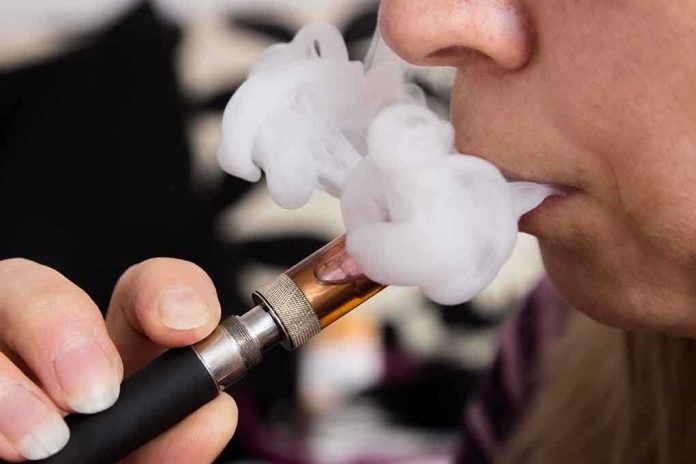
Even the healthiest-seeming young bodies can suddenly betray their owners, as one man’s collapsed lung after a decade of vaping shakes up everything we thought we knew about “safe” alternatives.
Story Highlights
- Long-term vaping may cause severe lung injuries, even in young, otherwise healthy individuals.
- Collapsed lung incidents expose a hidden risk not widely recognized by the public or medical community.
- Regulatory agencies and healthcare providers are re-evaluating vaping safety and intervention protocols.
- Ongoing cases and research challenge the perception of vaping as a harmless alternative to smoking.
Decade of Vaping Leads to a Shocking Collapse
A young man who started vaping as a teenager found his world upended nearly ten years later—his “healthy” lungs suddenly failed. He arrived at the hospital with stabbing chest pain and breathlessness, only to discover what few vapers anticipate: a spontaneous pneumothorax. The medical team inserted a chest tube and began a battery of tests, stunned by the absence of tobacco or cannabis history. Here was vaping alone, exposed as the culprit. The case has become a touchstone for both medical professionals and the public, sparking a reevaluation of vaping’s long-term risks and the fragility of youthful health.
With this incident, the conventional wisdom that vaping is a benign substitute for cigarettes faces a critical test. The patient’s ordeal—unexpected, severe, and isolated from other risk factors—forces a reconsideration of the health claims made by industry advocates. As chest tubes and hospital stays become the new reality for more young adults, the medical community finds itself playing catch-up, investigating what chemicals and mechanisms could trigger such catastrophic events in otherwise healthy lungs.
Historical Context: Vaping’s Rise and Unraveling
E-cigarettes were marketed in the early 2000s as a safer way to satisfy nicotine cravings and escape the dangers of smoking. What began as a harm-reduction tool quickly morphed into a youth-driven trend. By the time the 2019 EVALI crisis erupted, thousands had already landed in hospitals with mysterious lung injuries, most traced to adulterated THC cartridges. Yet, cases linked to plain nicotine vaping continued to slip through the cracks, dismissed or overlooked due to vaping’s “safer” branding. As regulatory scrutiny increased, sporadic reports of lung collapse kept surfacing, especially among young men with no history of smoking or chronic lung disease.
Systematic reviews now confirm that vaping-associated pneumothorax is no statistical fluke. The so-called “healthy vaper” is a recurring patient profile: young, active, with years of use and no warning signs—until the day a lung gives out. The EVALI outbreak may have faded from headlines, but the underlying dangers remain, quietly accumulating in emergency departments and scientific literature, awaiting broader recognition.
Stakeholders Confront Difficult Truths
This unfolding crisis pits a constellation of stakeholders against one another. The patient, struggling to recover and understand his plight, becomes a reluctant symbol of risk. Healthcare providers, particularly pulmonologists and emergency physicians, are compelled to broaden their screening and diagnostic protocols, looking for vaping connections in every unexplained lung injury. Public health agencies like the CDC and FDA respond with renewed warnings, even as e-cigarette manufacturers defend their products as necessary harm-reduction tools. Advocacy groups split along ideological lines—some push for tighter controls, others focus on pragmatic reduction of smoking-related deaths.
Regulatory agencies, armed with new data, wield the power to tighten standards and reshape public messaging. Manufacturers fight back with lobbying and PR, trying to preserve market share and consumer trust. Meanwhile, families and communities bear the cost—economic, emotional, and social—of hospitalized youth and uncertain futures. The medical establishment faces a challenge: how to balance harm reduction with the unpredictable hazards now emerging from long-term vaping.
Current Developments: Science and Policy in Flux
Recent months have seen a steady trickle of new vaping-related lung injury reports, including collapsed lungs in teens and young adults. Research teams are racing to pinpoint the mechanisms—what is it in the aerosol, the additives, or the device hardware that triggers sudden failure in seemingly robust lungs? Medical experts now recommend targeted screening for vapers who present with chest pain or breathing difficulties, urging early intervention to prevent recurrence. Surgical options are reserved for the most severe or repeated cases, but hospitalization and chest tubes are increasingly common outcomes.
Public health agencies continue to sound the alarm about unregulated and counterfeit vaping products. Most cases so far have been managed with standard interventions, yet recurrence rates remain troublingly high among those treated non-surgically. The timeline of vaping-related lung injury stretches from the EVALI peak in 2019 through sporadic cases in 2025, with no clear endpoint in sight. As research expands, the unpredictable nature of these injuries keeps policymakers and clinicians on edge.
Expert Analysis: Risk, Uncertainty, and the Path Forward
Pulmonologists and public health experts now warn that vaping carries acute and chronic risks, even for the healthiest individuals. Peer-reviewed studies and systematic reviews consistently document a pattern of spontaneous pneumothorax among young men with long-term e-cigarette use. Some researchers maintain that vaping is less harmful than smoking, but acknowledge it is not risk-free—a message often lost in industry marketing. Others emphasize the unpredictable and potentially catastrophic nature of lung injuries, advocating for caution and further research.
Credible sources—including the CDC and leading academic reviews—support the link between vaping and severe lung injury. The mechanisms remain under investigation, and the long-term effects are still unknown, but the evidence is mounting. For the e-cigarette industry, regulatory threats and reputational damage loom large; for the public health sector, the challenge is clear: education, prevention, and vigilance must intensify. The case of the young man’s collapsed lung is more than a medical anomaly—it is a harbinger of risks yet to be fully understood.
Sources:
PMC: Systematic Review of Vaping-Associated Pneumothorax
Lyracore: Vaping Lung Health in 2025
Cureus: Vaping-Associated Lung Injury Case Report







